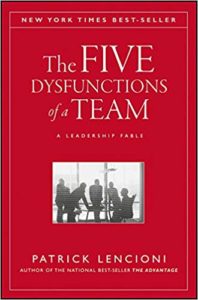If you’ve been following my latest business book reviews, you’ll notice they’ve been mostly of the storytelling type. They include The Energy Bus, The Go-Giver Leader, and Get A Grip. I like business books written in this style. They’re much easier to read than business books written like academic textbooks. They’re more entertaining, obviously. Best of all, when they’re written well, I learn from them.
Therefore, it should come as no surprise that my latest business book read was also of the fable variety. My nemesis, the Amazon recommendation engine, has clearly figured me out. It suggested The Five Dysfunctions of a Team by Patrick Lencioni, multiple times. I finally relented, purchased the book, and added it to my reading list.
The book’s story revolves around a character by the name of Kathryn Petersen. She has taken over as CEO of a well-funded start-up that is significantly under-performing in spite of its significant financial backing and the talented and experienced team that has been assembled. Kathryn’s job is to get the company back on-track and performing to expectations. She determines that the cause of the poor performance is due to the dysfunctional nature of the leadership team, which has rippled throughout the organization. Before worrying about product features, development execution, and competition, she realizes that she has to get the team on the same page. As one of Lencioni’s successful friends once stated, “If you could get all the people in an organization rowing in the same direction, you could dominate any industry, in any market, against any competition, at any time.” Lencioni points out that building such a team is possible, and simple to do. However, it is painfully difficult.
From that introduction, Lencioni introduces his framework that addresses the five dysfunctions of a team. His framework starts with building trust. The second step is fostering productive conflict. Third is making firm commitments to team direction and decisions. Fourth is the ability of team members to hold each other accountable. The final step is placing the success of the team ahead of one’s personal goals and status. Through the story, Lencioni shows how Kathryn works with them team to address each one of the five dysfunctions.
The Five Dysfunctions is a good book for confronting the issues that face most teams. While not all teams will exhibit all five dysfunctions, it’s likely that any team, especially one that is under-performing, will exhibit at least 2 or 3 of them. The challenge for any leader is addressing the issues head on while keeping the team’s performance at a level that doesn’t further impact company performance. I believe this would be a tough task, and one that would benefit from an outside observer, or consultant if you will, to aid the team through the transition.
While I liked the book, it’s too early in my company’s stage to be directly applicable. I would like to revisit the book and its concepts when I grow my team to ensure that I start down the right path. Starting down the right path would make it much easier to adjust team dynamics later rather than waiting for issues to arise that would require a makeover of the team.
In any case, I would say The Five Dysfunctions of a Team is definitely worth exploring if you lead or manage a team. I’m sure you’ll be able to pull a few items out of the book that you can apply to your team to improve its performance. I also expect it would work at any level of an organization, although I feel it would have more impact the higher in the organization the concepts are applied. Filtering the right team dynamics and behaviors downward through an organization is easier than trying to bubble them up.
Somehow, during the second half of 2019, my reading leaned heavily towards business and non-fiction books. In fact, it got a little too heavy. Now don’t get me wrong, I like books of this genre, but I also like to mix it up with fiction. To guard against this in 2020, I’ve made an adjustment to my reading list. I moved most, if not all, of the the non-fiction and business books to my morning reads. My evening reads are now primarily fiction based, with a heavy emphasis on science fiction. You can expect to see a few more entertaining book reviews as we get deeper into the new year.

